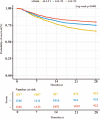Association between advanced lung cancer inflammation index and mortality in critically ill septic patients: analysis of the MIMIC-IV database
- PMID: 40413403
- PMCID: PMC12103769
- DOI: 10.1186/s12879-025-11116-w
Association between advanced lung cancer inflammation index and mortality in critically ill septic patients: analysis of the MIMIC-IV database
Abstract
Background: Septic patients often face high mortality rates, influenced by various factors, including inflammation and nutritional status. This study investigates the relationship between the Advanced Lung Cancer Inflammation Index (ALI), an indicator of inflammation and nutritional status, and mortality rates (28-day, in-hospital, and ICU) in septic patients.
Methods: We conducted a retrospective analysis using data from the Medical Information Mart for Intensive Care IV (MIMIC-IV) database, focusing on septic patients. Our primary analysis tools were multivariate logistic regression and restricted cubic spline (RCS) to examine the association between ALI and mortality outcomes. Additionally, subgroup and sensitivity analyses were performed to validate the findings.
Results: The study included 3,739 septic patients. Results showed that higher ALI levels were significantly associated with reduced 28-day and in-hospital mortality rates. Specifically, a one-unit increment in natural log-transformed ALI was linked to a 16% reduced risk of 28-day mortality (p < 0.001) and a 12% reduced risk of in-hospital mortality (p = 0.002). These findings were consistent across different subgroups, confirming the stability of the results.
Conclusions: Elevated ALI levels are associated with lower mortality rates in septic patients, suggesting ALI as a potential prognostic marker for this group. However, further large prospective studies are needed to corroborate these findings and explore the implications for clinical practice.
Keywords: Advanced lung cancer inflammation index; Inflammation; MIMIC-IV database; Mortality; Nutrition; Sepsis.
© 2025. The Author(s).
Conflict of interest statement
Declarations. Ethics approval and consent to participate: The dataset utilized in this study was sourced from MIMIC-IV. To gain access to the database, we completed the CITI Program course on Human Research and Data or Specimens Only Research and obtained permission (Record ID: 57548122, 57743676, and 59905651). Patient information within this database was anonymized, and ethical review and informed consent requirements were waived. All procedures were conducted in compliance with applicable guidelines and regulations. Consent for publication: Not applicable. Competing interests: The authors declare no competing interests.
Figures






References
-
- Reinhart K, Daniels R, Kissoon N, Machado FR, Schachter RD, Finfer S. Recognizing sepsis as a global health priority - a WHO resolution. N Engl J Med. 2017;377(5):414–7. - PubMed
-
- Gaieski DF, Edwards JM, Kallan MJ, Carr BG. Benchmarking the incidence and mortality of severe sepsis in the United States. Crit Care Med. 2013;41(5):1167–74. - PubMed
MeSH terms
Grants and funding
- XSJ-2021-02/Tianjin Medical University General Hospital "New Century Talents" Cultivation Project
- 303078100501/Tianjin Medical University General Hospital Young and Middle-Aged Scientific Research Cultivation Fund
- 82100352/National Natural Science Foundation of China
- 82202212/National Natural Science Foundation of China
LinkOut - more resources
Full Text Sources
Medical

